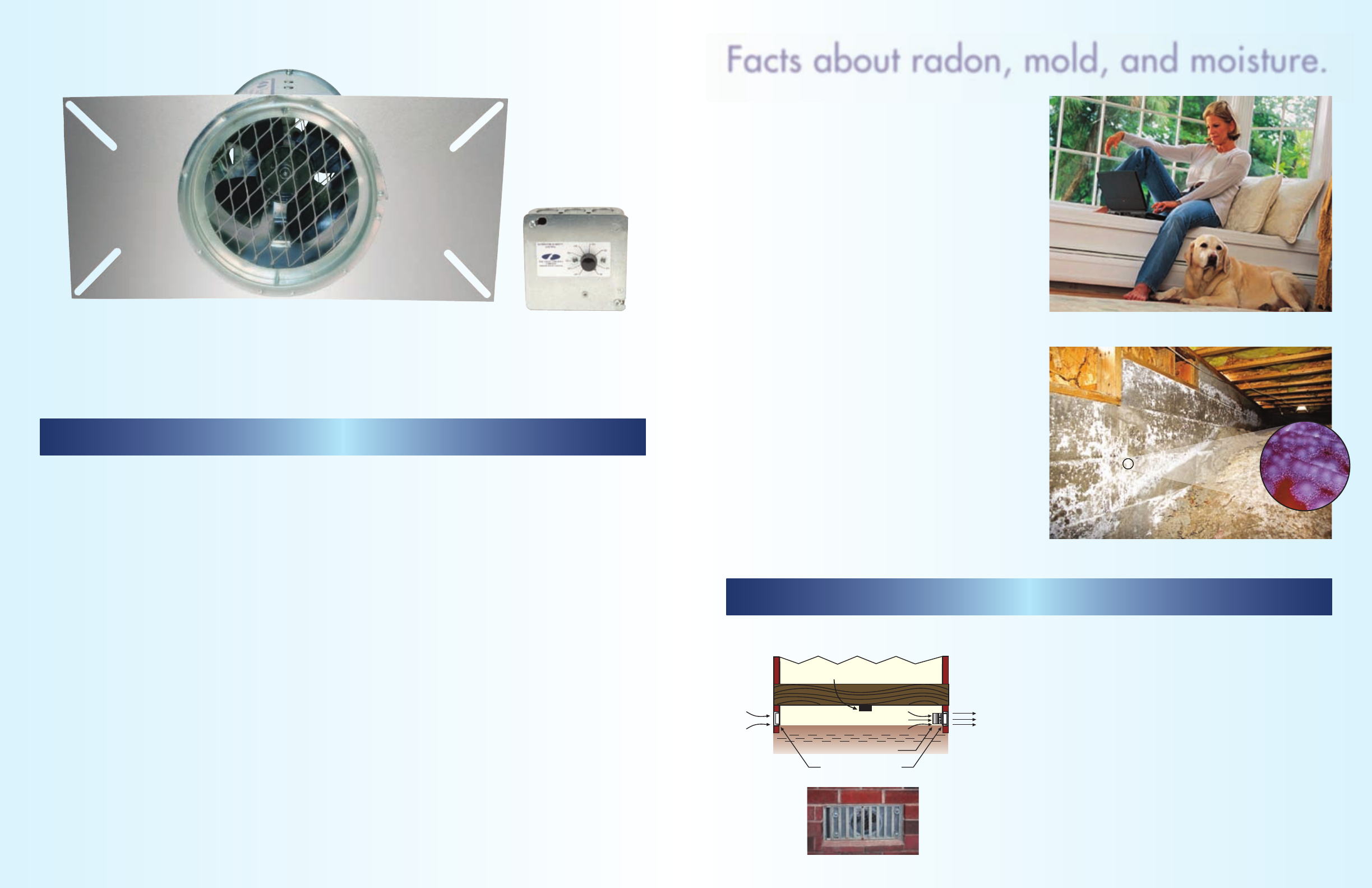
Crawl space
The Eliminator
®
Foundation vents
De-humidistat
Typical crawl space under home with mold growth
Facts about radon, mold, and moisture.
Mold
1. The Eliminator is attached to any standard foundation
vent, and then wired to a 120v source.
2. Optional de-humidistat is placed in center of crawl
space area.
3. When temperature in crawl space exceeds 50
o
F
and/or when humidity exceeds de-humidistat setting,
the Eliminator is engaged.
4. Moist air and radon gases are pulled from crawl
space and replaced with fresh, outside air.
5. When thermostat or de-humidistat are satisfied, the
Eliminator is deactivated.
Typical installation
How it works
• Reduces moisture content and mold
potential in crawl spaces, floor joists,
flooring, and other support wood
• Circulates air in crawl space
• Removes radon gas
• Automatic operation
• Temperature or humidity activated
• Reduces potential for airborne mold
infiltration into home
• Reduces termite potential
The Eliminator Foundation Vent Fan is a motorized fan
designed to circulate fresh air in a home or building
crawl space to eliminate cancer-causing radon gas and
reduce moisture that can lead to mold formation and
termite infestation. The Eliminator attaches to virtually
any standard foundation vent. It is wired for automatic
operation when the temperature exceeds 50
o
F. An
optional de-humidistat activates the fan when humidity
exceeds the owner-determined setting (20%–80%) in
conjunction with the built-in temperature control.
The temperature control is shielded from the sun to
prevent false readings that could lead to costly
operation during cold weather.
Note: The de-humidistat is designed to be installed
remotely, so it can be placed in the crawl space where
moisture is most likely to accumulate.
FieldControls, LLC | The Venting Solutions Company | www.fieldcontrols.com
Optional De-humidistat
The Eliminator Foundation Vent Fan
How it works
The Eliminator Foundation Vent Fan
Radon
Radon is a radioactive gas that is considered to be a health
hazard affecting indoor air quality worldwide. Radon gas
is the second most common cause of lung cancer in the
United States. One in fifteen homes in the U.S. has a
high level of radon.
Mold
According to a study by the Mayo Clinic, nearly all
chronic sinus infections are a result of mold. Since up to
40% of the air we breathe in the home can come from
the crawl space, mold in the crawl space means mold in
the home. The EPA recommends to keep humidity levels
in the crawl space to 40%–50% to reduce the likelihood
of mold formation.
Moisture
Excess moisture in a crawl space can have serious conse-
quences. Not only can it lead to mold formation, it also
increases termite potential and can increase the potential for
rot in floor joists, cross members, and sub-flooring. Moisture
level in wood should be less than 20%. In high humidity
areas, that number can easily exceed 30%. To maintain safe
moisture levels, experts recommend a plastic moisture
barrier on the ground in combination with a vent fan such
as the Eliminator.
7027FCHEliminatorBrochure:7027FCHEliminatorBroc11x17 option 2/6/08 4:06 PM Page 4




